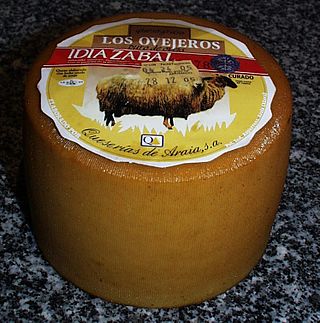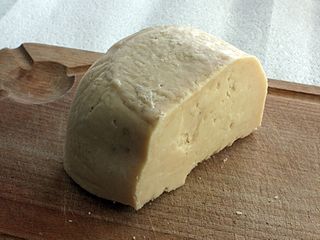
Mozzarella is a semi-soft non-aged cheese prepared by the pasta filata method with origins from southern Italy.

Idiazabal is a pressed cheese made from unpasteurized sheep milk, usually from Latxa and Carranzana sheep in the Basque Country and Navarre regions of Spain. It has a somewhat smokey flavor, but is usually un-smoked.

Gorgonzola is a veined PDO Italian blue cheese, made from unskimmed cow's milk. It can be buttery or firm, crumbly and quite salty, with a "bite" from its blue veining. Outside the EU and the countries recognizing the geographical origin protection, the name "Gorgonzola" can legally be used for similar cheeses, with only the full Italian name unambiguously referring to PDO Gorgonzola. It is a famously pungent cheese.

The following four classifications of wine constitute the Italian system of labelling and legally protecting Italian wine:

Goat cheese, goat's cheese or chèvre is cheese made from goat's milk. Goats were among the first animals to be domesticated for producing food. Goat cheese is made around the world with a variety of recipes, giving many different styles of cheeses, from fresh and soft to aged and hard.

Caciocavallo is a type of stretched-curd cheese made out of sheep's or cow's milk. It is produced throughout southern Italy, particularly in the Apennine Mountains and in the Gargano peninsula. Shaped like a teardrop, it is similar in taste to the aged southern Italian provolone cheese, with a hard edible rind.

Asiago is a cow's milk cheese, first produced in Asiago in Italy, that can assume different textures according to its aging, from smooth for the fresh Asiago to a crumbly texture for the aged cheese. The aged cheese is often grated in salads, soups, pastas, and sauces while the fresh Asiago is sliced to prepare panini or sandwiches; it can also be melted on a variety of dishes and cantaloupe. It is classified as a Swiss-type or Alpine cheese.

Buffalo mozzarella is a mozzarella made from the milk of the Italian Mediterranean buffalo. It is a dairy product traditionally manufactured in Campania, especially in the provinces of Caserta and Salerno.

Grana Padano is a cheese originating in the Po Valley, in Northern Italy, that is similar to Parmigiano Reggiano. There are less strict regulations governing its production compared to Parmigiano Reggiano. This hard, crumbly-textured cheese is made with unpasteurized cows' milk that is semi-skimmed through a natural creaming process. To preserve the authenticity of the manufacturing processes and raw materials used to make this cheese, Grana Padano is registered as Geographical Indication in Italy since 1954 and as a European Union protected designation of origin (PDO) since 1996, and is protected in several other countries based on the Lisbon Agreement and bilateral agreements.

Pecorino sardo is a firm cheese from the Italian island of Sardinia, made from sheep's milk, specifically from the milk of the local Sardinian breed. It was awarded denominazione d'origine status in 1991 and granted protected designation of origin protection in 1996, the year in which this European Union certification scheme was introduced.

Santo Stefano d'Aveto is a comune (municipality) in the Metropolitan City of Genoa in the Italian region Liguria.

Ragusano is an Italian cow's-milk cheese produced in Ragusa, Sicily. It is a firm stretched-curd cheese made with whole milk from cows of the Modicana breed, raised exclusively on fresh grass or hay in the provinces of Ragusa and Syracuse.

Bitto is an Italian DOP cheese produced in the Valtelline Valley, in Lombardy. It owes its name to the Bitto River. Bitto is produced only in the summer months, when the cows feed on the high alpine meadows.

Formaggio di fossa is an Italian cheese originating from Sogliano al Rubicone, in the province of Forlì-Cesena, Emilia-Romagna.
Spressa delle Giudicarie is an Italian cheese that comes from the region of Trentino-Alto Adige/Südtirol. The Spressa delle Giudicarie can be consumed fresh after three months, while curing takes more than six months. The cheese is made in cylindrical shape, about 25 cm (9.8 in) in diameter. The crust is brown, the interior of the cheese is white to very pale yellow with small to medium-sized holes. The cheese is eaten when still young. It is a cow's milk cheese Rendena race mostly, from two milkings, the evening and the morning.

Pecorino di Filiano is a firm cheese from the Italian region of Basilicata made from sheep milk. It was granted protected designation of origin (PDO) in 2007.

Quartirolo Lombardo is a soft cheese made with cow's milk, which has a Protected designation of origin (PDO) status.















